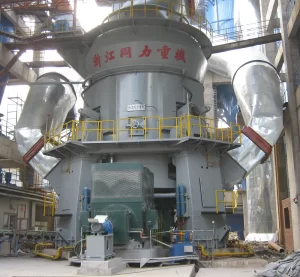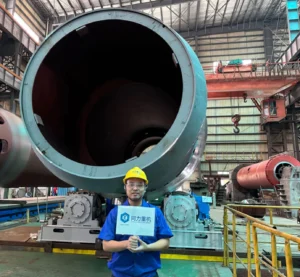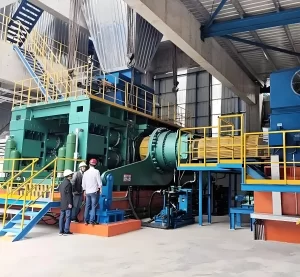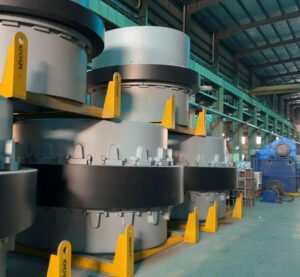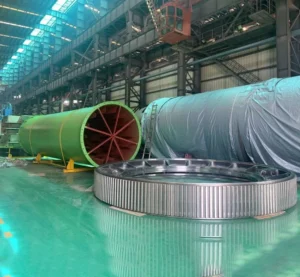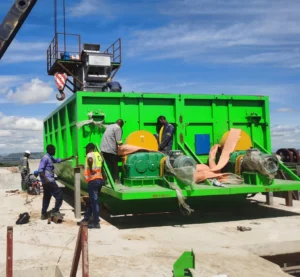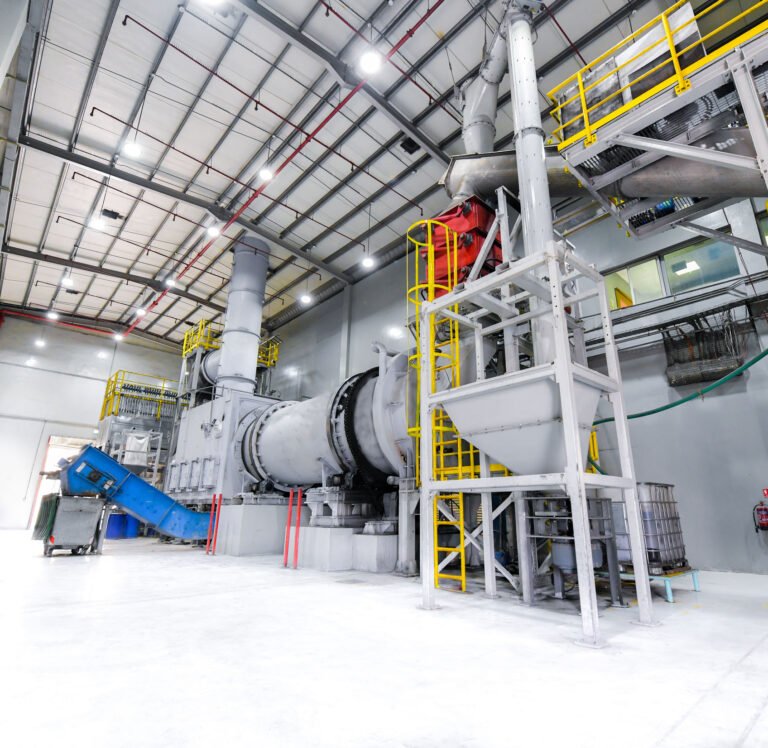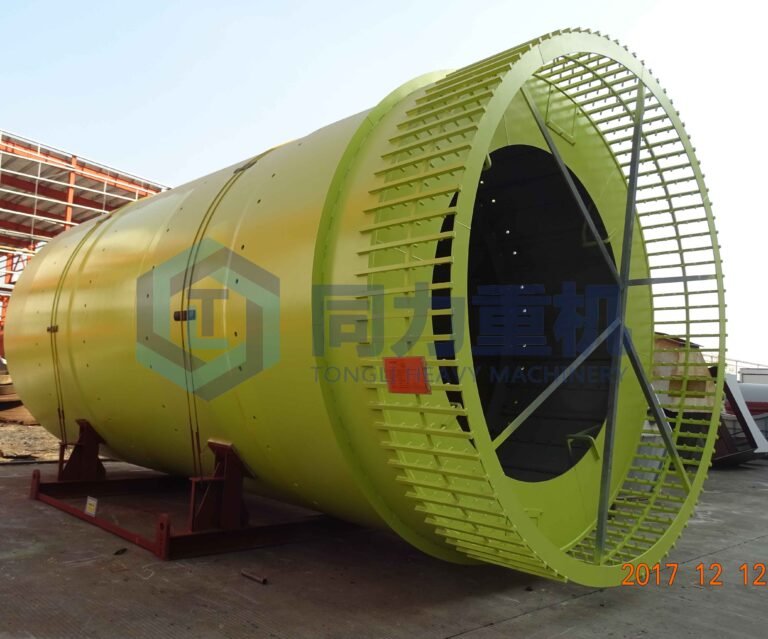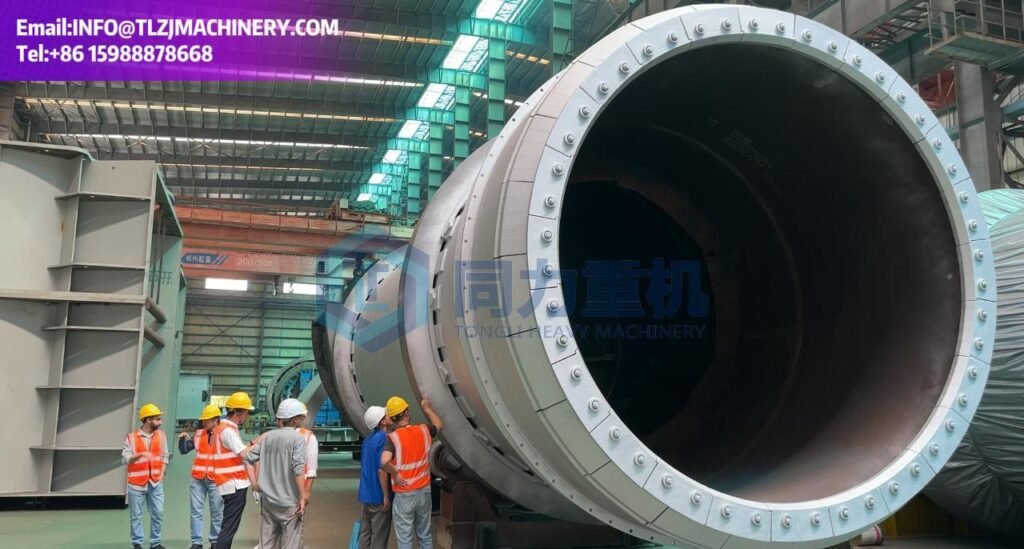
Introduction:
In August 25th, 2025 Representatives from the Omani Environmental Services Holding Company (be’ah) visited TONGLI to inspect the manufacturing progress of their 4x15m incineration rotary kiln and the SCC secondary combustion chamber. During the visit, the project manager, Mr. Thomas Ritz Nissen, observed several key stages of production. He witnessed the test run of the friction-drive rotary kiln transmission system, ensuring that the equipment operates smoothly and meets the required performance standards. In addition, he reviewed the welding procedures being applied on critical components and examined part of the NDT (Non-Destructive Testing) documentation, which serves as proof of quality and reliability in line with international standards. This inspection not only confirmed that the project is advancing according to plan but also strengthened the confidence of be’ah in TONGLI’s technical expertise and manufacturing capabilities. The 4x15m rotary kiln and SCC secondary combustion chamber are core units of the waste treatment system and are designed to handle hazardous materials with high efficiency, safety, and environmental compliance. By closely monitoring each step of the production process, be’ah ensures that the equipment delivered will meet both operational expectations and environmental regulations, supporting the company’s long-term goal of sustainable and responsible waste management in Oman.
What is a hazardous waste incineration rotary kiln for Be'ah?
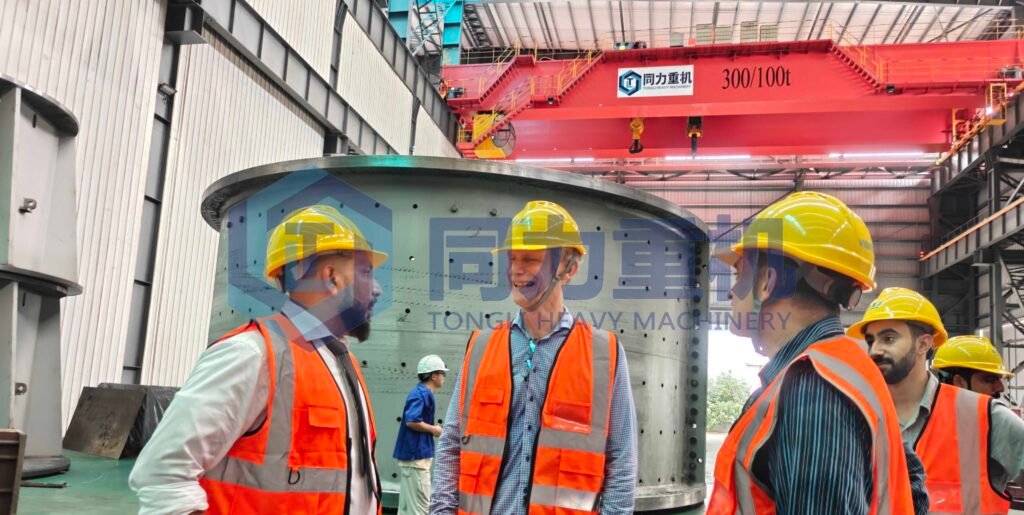
The Phase II project of be’ah’s Sohar Industrial Waste Treatment Facility includes a specialized hazardous waste treatment plant alongside physico-chemical processing, used oil treatment, smart storage tanks, and enhanced infrastructure. The facility is intended to manage a wide range of hazardous industrial waste types, including used oils, chemical solvents, toxic waste, and other industrial byproducts. This aligns with regional waste management practices where such diversified waste streams are typical. It’s a rotating, refractory-lined steel cylinder, tilted slightly (around 5°) so materials move through it as it turns. Wastes—whether solid, sludge, liquid, or even drummed—are introduced via feeding systems and undergo high-temperature combustion (typically 800–1,300 °C), After initial incineration in the rotary kiln (primary chamber), gases move into a secondary combustion chamber (SCC) where residual pollutants are fully oxidized at high temperatures and sufficient residence time is ensured. This systems are designed to recover heat, converting it into steam, electricity, or hot water, enhancing energy efficiency and offering potential waste-to-energy benefits like for this project specifically is to purify the salt water to make distilled water.
What is the structure of a Be'ah Incineration rotary kiln?
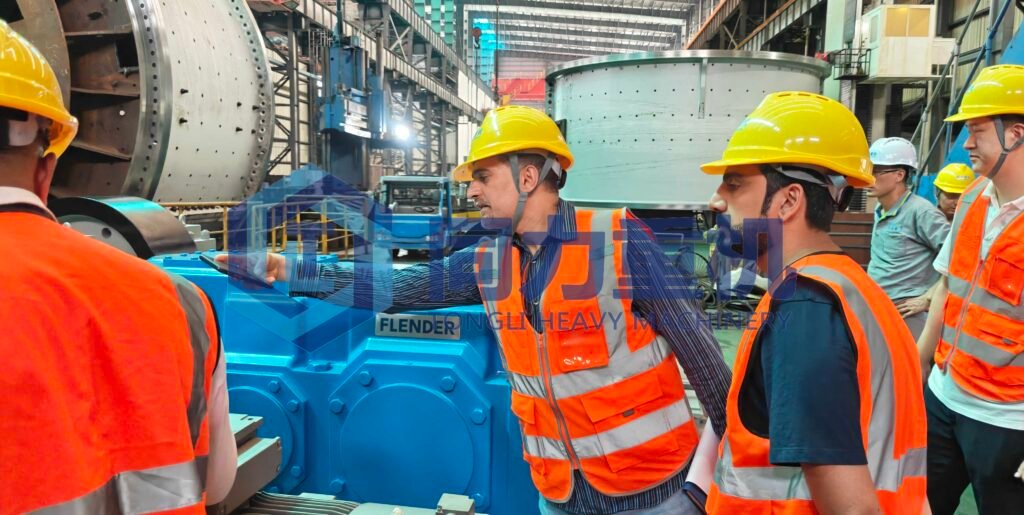
A hazardous waste incineration rotary kiln designed by us to safely destroy solid, liquid, and sludge-based hazardous wastes under controlled high-temperature conditions. Structurally, it is a long cylindrical steel shell that is slightly inclined and slowly rotates on support rollers. The interior is lined with thick refractory bricks to withstand temperatures up to 1,400 °C and protect the shell from chemical attack. Waste is fed into the higher end of the kiln through solid waste chutes, liquid injection lances, or sludge feeders. As the kiln rotates, the waste continuously tumbles and moves toward the lower end, passing through different combustion stages including drying, volatilization, ignition, and burnout. A main burner installed at the front end supports combustion by providing the necessary flame and auxiliary fuel. Residual ash and slag are discharged at the bottom and quenched before further handling.
What is the secondary combustion chamber(SCC) of a hazardous waste incineration plant?
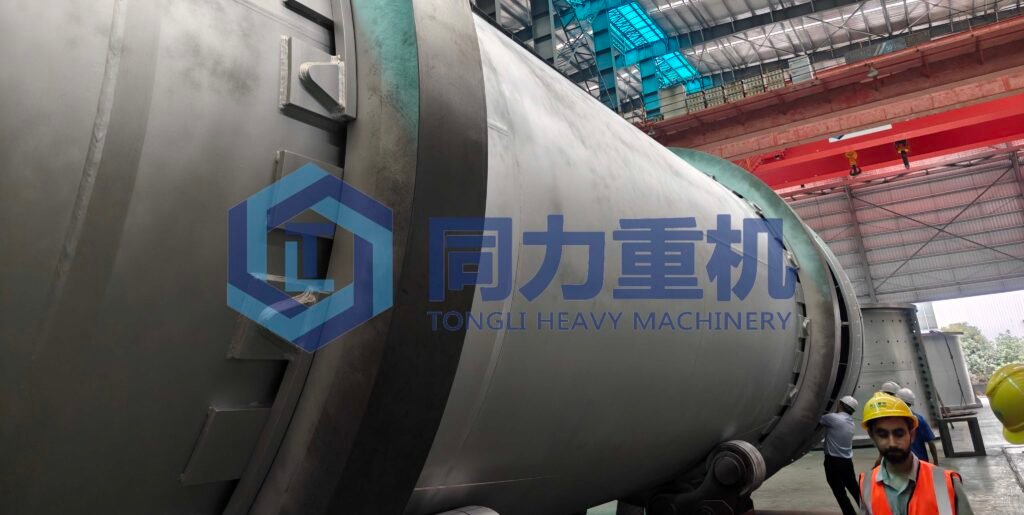
Downstream of the kiln, the Secondary Combustion Chamber (SCC) plays a critical role in ensuring complete oxidation of gases and volatile compounds released from the waste. The SCC is a large, refractory-lined chamber where the flue gases are exposed to very high temperatures, typically between 850 °C and 1,200 °C, for a minimum residence time of two seconds, as required by international emission standards. Secondary burners and air injection nozzles maintain high turbulence, oxygen supply, and thermal stability, allowing for the destruction of harmful organics such as dioxins, furans, and volatile organic compounds. This guarantees that the exhaust leaving the SCC is fully combusted and significantly less toxic.
How to reclaim the energy generated in the hazardous waste incineration process?
After leaving the SCC, the hot gases may pass through a waste heat recovery boiler, where excess energy can be converted into steam or electricity, improving overall plant efficiency. The cleaned gases are then treated in a multi-stage air pollution control system. This typically includes cyclones or baghouse filters for particulate removal, wet or dry scrubbers for neutralizing acid gases, and activated carbon systems for capturing heavy metals and trace organic pollutants. Finally, the purified gas is released through a stack under continuous emission monitoring. In essence, the rotary kiln provides the first stage of waste destruction, breaking down hazardous materials into ash and volatile gases, while the secondary combustion chamber ensures complete oxidation of all residual pollutants. Together, the RFK (Rotary Kiln Furnace) and SCC system form the heart of a hazardous waste incineration plant, offering a reliable solution for managing toxic industrial, chemical, and medical wastes.
About The Client: Who is Be'ah?
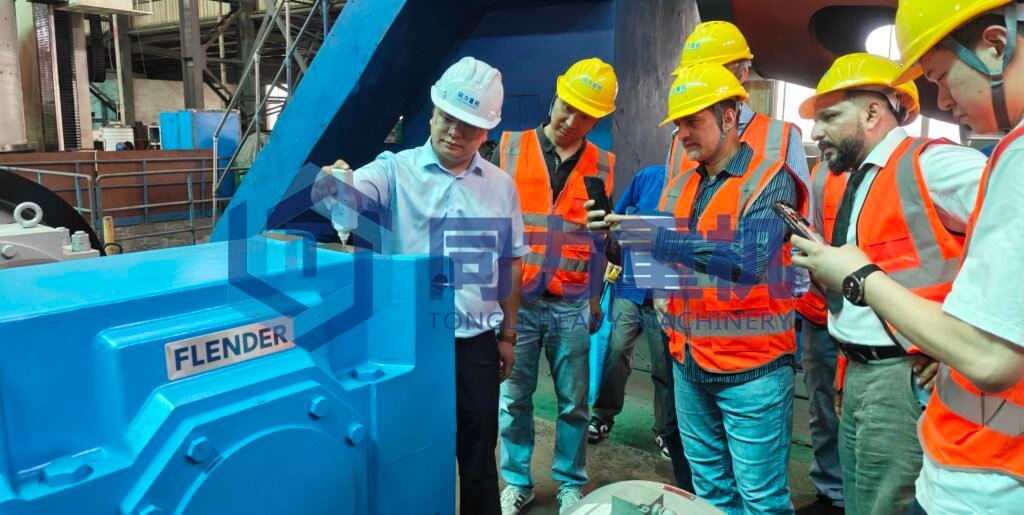
Be’ah (Oman Environmental Services Holding Company) is a government-owned company in Oman responsible for managing the country’s waste and developing sustainable waste solutions. It was established in 2007 and operates under the Oman Investment Authority (OIA).
- Managing municipal solid waste, industrial waste, and hazardous waste across Oman.
- Developing and operating landfills, transfer stations, treatment plants, and recycling facilities.
- Promoting a circular economy by reducing landfill use, increasing recycling, and encouraging energy recovery from waste.
- Partnering with international organizations and companies to bring in advanced waste management technologies.
What does Be'ah Do?
Be'ah leverages waste-to-energy incineration and mechanical-biological treatment technologies to establish a comprehensive management and treatment system covering municipal solid waste, hazardous waste, and medical waste. Following the closure of Barka Landfill Area 1 and Al Multaqa Landfill Area 1, the company is further implementing gas extraction at the decommissioned landfills to reduce the potential harm of landfill gas emissions to the environment, ecology, and public health. The extracted gas will be primarily used for power generation. If reuse is not feasible, it will be disposed of harmlessly through standardized combustion.
Be'ah is a leader in Global Medical Waste Management
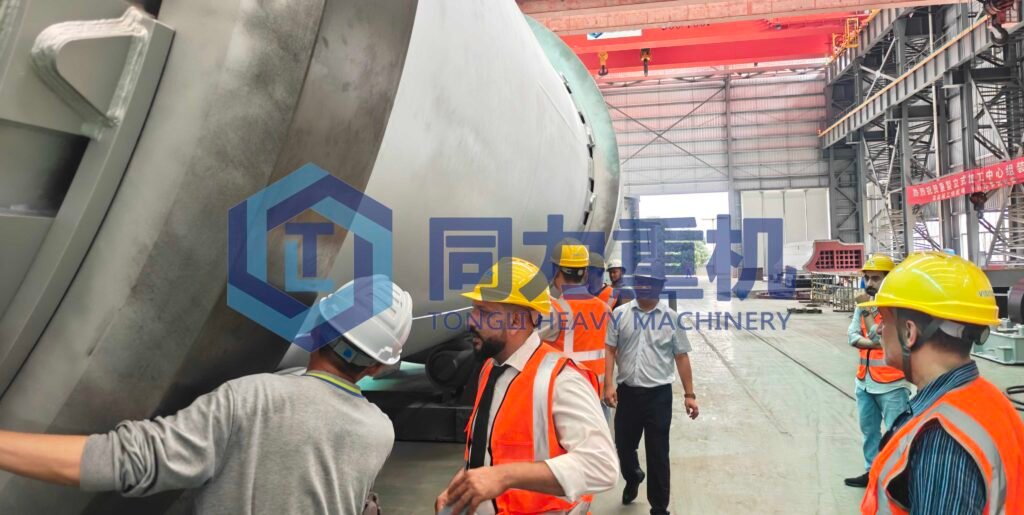
Be'ah has consistently maintained its leading position in medical waste management, a position that has been particularly evident following the global COVID-19 outbreak. The company utilizes two core technologies for the treatment of medical waste: incineration for complete disposal and autoclave sterilization (a specialized device that sterilizes waste to render it harmless). Furthermore, Be’ah received widespread recognition for its contribution to the International Sustainability, Resources, and Technology Conference during Oman Sustainable Development Week. The conference provided an in-depth discussion on various environmental issues and provided an important platform for industry exchange. Notably, Be’ah has been recognized for two consecutive years by the International Solid Waste Association (ISWA) and this time received the ISWA Award for Best Communication Campaign, demonstrating its strength in both industry practice and communication.
What service does Be'ah provide?
1. Municipal Solid Waste (MSW) Management
- Collects household and commercial waste from all governorates.
- Operates transfer stations where waste is consolidated before transport.
- Runs engineered landfills to replace old dumping sites.
- Provides street sweeping and cleaning services in cities.
2. Hazardous & Industrial Waste Management
- Operates the Sohar Industrial Waste Treatment Facility (largest in Oman).
- Handles hazardous waste from oil & gas, petrochemicals, mining, and manufacturing.
- Provides physico-chemical treatment, solidification, and incineration for toxic waste.
- Manages used oil treatment and smart storage solutions.
3. Medical & Healthcare Waste Management
- Collects and treats waste from hospitals, clinics, and laboratories.
- Uses incinerators and sterilization technologies to safely dispose of infectious and hazardous medical waste.
4. Recycling & Resource Recovery
- Runs initiatives for paper, plastics, metals, and glass recycling.
- Implements programs for e-waste (electronics), end-of-life vehicles, and tires.
- Supports the development of a circular economy to turn waste into resources.
5. Environmental & Sustainability Services
- Conducts awareness campaigns and training programs for schools, companies, and communities.
- Partners with international organizations to bring best global practices in waste management.
- Develops projects for energy-from-waste (EfW) and sustainable infrastructure.
6. Specialized Facilities Across Oman
- Sohar → Industrial & hazardous waste treatment facility.
- Duqm → Industrial & municipal waste landfill + organic waste handling.
- Thamrait → Industrial waste treatment and disposal site.
- Multiple transfer stations and engineered landfills nationwide.
Project Background:

Be’ah secures RO51mn financing for sohar waste management expansion
The Omani Environmental Services Holding Company, known as be’ah, has signed a financing agreement with ahli islamic worth OMR 51 million (around USD 132.5 million) to launch the second phase of its industrial waste treatment project in the Sohar Free Zone. This step comes after the successful operation of the first phase, which includes industrial landfills, solid waste storage facilities, a solidification plant, and a specialized laboratory accredited by the Gulf Accreditation Centre—the only one of its kind in Oman. The second phase will focus on building a specialized hazardous waste treatment plant, upgrading physico-chemical treatment technologies, and setting up modern facilities for managing used oils and highly toxic waste. It will also include smart storage tanks and advanced infrastructure to improve efficiency and safety. The project is designed to comply with the Basel Convention on hazardous waste management, ensuring it meets international environmental standards. According to be’ah officials, the expansion will not only improve Oman’s waste management capacity but also support the goals of Oman Vision 2040 by promoting the circular economy, creating jobs, enhancing in-country value (ICV), and providing critical infrastructure for the country’s growing industrial sector.
Muscat: Oman's largest industrial waste treatment facility opens in Sohar
In the Sohar district of North Al Batinah Governorate in the Sultanate of Oman, a landmark large-scale industrial waste treatment facility has officially commenced operations. Not only is it currently the largest of its kind in the country, but it will also be gradually expanded through multi-phase construction to fully handle the treatment of industrial and hazardous waste nationwide. The facility is scheduled for completion in 2025, with the capacity to treat all types of industrial and hazardous waste in Oman, providing critical support for the country's environmental governance.
Oman Environmental Services Holding Company (be'ah), the state-owned agency responsible for solid waste management nationwide, announced the successful completion and commencement of operations of the first phase of the Sohar Industrial Waste Treatment Facility. The first phase includes three landfills with both open and closed industrial waste treatment areas. The subsequent second phase will include a solidification treatment unit and specialized laboratory facilities to further enhance the professionalism and safety of waste treatment. With the opening of the Sohar facility, the temporary waste storage area previously located in the nearby Liwa region will be phased out. All existing waste in the area will be transferred to the Sohar facility for standardized treatment, effectively addressing the environmental risks associated with temporary storage.
For Oman, modern industrial waste treatment and disposal infrastructure is a key cornerstone for the sustainable development of the country's industry and manufacturing sector, particularly crucial for the healthy development of key waste-producing sectors such as oil and gas, petrochemical refining, mining, and mineral processing. According to statistics, the Sohar facility received and processed approximately 11,000 tons of industrial waste in 2021 alone. In terms of waste definition, be'ah clearly classifies "waste generated during industrial production, as well as waste generated from mining, oil and gas extraction, and hydropower production activities" as industrial waste, and in most cases, this waste is also classified as hazardous waste. "In handling all industrial waste streams, be'ah prioritizes the preservation of Oman's natural environment, infrastructure safety, and operational compliance as core principles. In 2021, we will continue to collaborate with leading global sustainability and environmental organizations to ensure we remain at the forefront of industrial waste treatment technologies and practices," said be'ah, a subsidiary of the Oman Investment Authority (OIA).
In addition to the Sohar facility, Oman has established multiple channels for the treatment of small amounts of non-hazardous industrial waste: municipal solid waste treatment stations nationwide handle this waste, while industrial waste treatment facilities in Sohar and Tamrat also participate. Furthermore, within the large-scale Duqm Special Economic Zone, be'ah has partnered with the local government to build an integrated waste treatment facility dedicated to the treatment of municipal and industrial waste in the area. The facility's landfill primarily accepts inorganic industrial waste, with dedicated storage and processing areas for organic industrial waste requiring incineration and pre-treatment prior to landfill. The Duqm Industrial Waste Treatment Facility officially began accepting waste in the fourth quarter of 2021.
What is the relationship between Tialoc and Tongli?
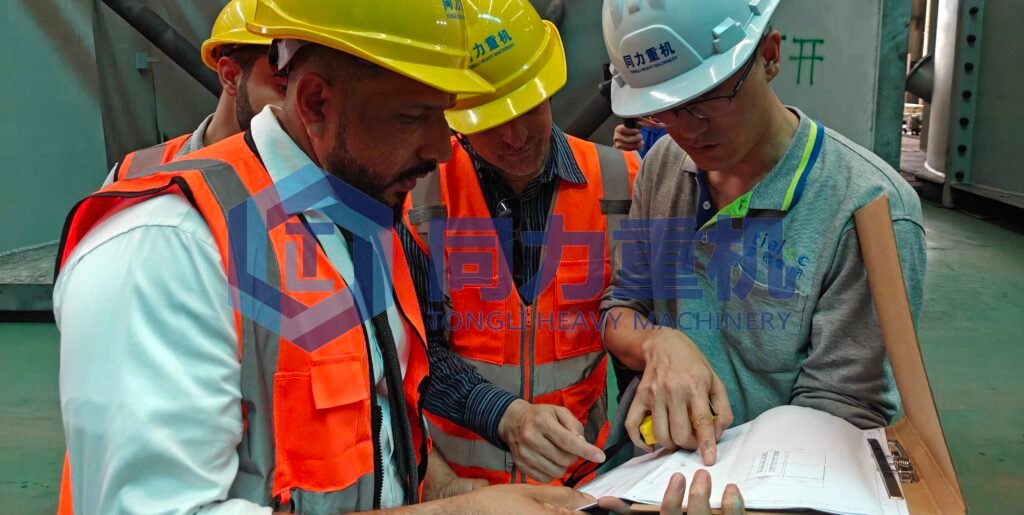
Tialoc partners with TONGLI Heavy Machinery as its OEM manufacturing base for high-temperature waste-treatment equipment—especially rotary-kiln incinerators with secondary combustion chambers and associated systems. Together, the companies have delivered hardware for the Cleanco Medical & Hazardous Waste Incineration Plant (Abu Dhabi, UAE), where a TONGLI-manufactured rotary kiln is in operation, and for be’ah’s Sohar Industrial Waste Treatment Facility – Phase 2 (Sohar Free Zone, Oman), where Tialoc (with Al Ramooz) is the EPC contractor and TONGLI serves as a key equipment supplier. And for Singapoer ECO special waste management pte ltd(Founded in 1997 and 100% owned by Séché Environnement, ECO is one of the leading waste management solutions providers in Singapore.) Tongli is the main equipment supplier. And for Mo-BRUK S.A. (a leading Polish company specializing in the processing of hazardous and non-hazardous industrial waste) Tongli also supplied most of the equipment.
What is the relationship between Cleanco Waste Treatment LLC and Be'ah Oman Environmental Services Holding Company?
While Cleanco Waste Treatment LLC (UAE) and be’ah (Oman) do not have a direct partnership or joint projects, they share a key similarity in their operations: the main equipment used in both companies’ hazardous waste treatment plants—the RFK rotary kiln incinerator and the SCC secondary combustion chamber—is manufactured by Zhejiang TONGLI Heavy Machinery. TONGLI serves as the OEM equipment supplier, providing the state-of-art core high-temperature waste treatment systems equipment that form the backbone of both Cleanco’s and be’ah’s facilities. This common reliance on TONGLI manufacturing capability highlights a technical connection in their approach to industrial and hazardous waste management, even in the absence of a formal collaboration.
Why Waste Management is important to Oman?
Currently, Oman is in a critical stage of accelerated urbanization and steady economic growth. This development trend has directly led to a significant increase in the amount of garbage generated. With the continuous expansion of the population and the continuous expansion of the industrial field, how to achieve efficient garbage management has become a key priority in Oman’s national development agenda. In response to this demand, the Omani government has actively deployed a number of garbage management strategies. The core goal is to promote the implementation of the concept of sustainable development while effectively reducing the environmental pollution that may be generated during the garbage disposal process. In this process, Be'ah, as the core agency responsible for waste management in Oman, has always played a leading role. With its professional capabilities and resource advantages, the agency provides advanced garbage management solutions covering multiple fields.
Waste Generation Scale and Core Disposal Challenges in Oman
- High reliance on landfills: Landfills account for over 90% of all municipal solid waste disposal methods. This traditional disposal model not only consumes significant land resources but also poses potential environmental hazards to surrounding soil, water, and air due to issues such as leachate and landfill gas, significantly falling short of sustainable development goals.
- Weak recycling infrastructure: The country's waste sorting system is underdeveloped, and the coverage and processing capacity of specialized recycling facilities are limited. This situation directly restricts the efficient resource utilization of waste, resulting in a large amount of recyclable resources being mixed with regular waste for disposal, hindering the advancement of sustainable waste management models.
- Prominent food waste: Food waste accounts for a significant proportion of municipal solid waste. This type of waste is prone to rotting and deterioration, not only generating odor and pollution during collection and transportation, but also resulting in significant resource waste due to ineffective recycling (such as conversion into organic fertilizer), which in turn increases the pressure on landfills.
- Hazardous waste disposal capacity needs improvement: Oman still faces challenges in standardizing the collection and proper disposal of hazardous waste generated by industrial production and specific sectors. Due to the corrosive and toxic properties of hazardous waste, specialized technologies and dedicated treatment facilities are required. Currently, the coverage and professionalism of related solutions need to be further strengthened.
Therefore in order to sovle these problems...
Government-level initiatives and policy support led by Be'ah
To systematically address the aforementioned waste management challenges, Oman Environmental Services Holding Company (Be'ah), as the leading organization in Oman's waste management sector, is actively promoting the modernization of the country's waste management industry and collaborating with various stakeholders to implement a number of key initiatives:
Promoting the implementation of the National Waste Management Strategy:
This strategy, with the core goal of reducing reliance on landfills and improving resource recovery efficiency, provides a unified direction and action framework for national waste management by clearly defining tasks and quantitative indicators for each phase, gradually guiding the industry's transition from "end-of-life disposal" to "source reduction and resource utilization."
Deepening Public-Private Partnership (PPP) Models:
Be'ah is actively building a public-private partnership platform, encouraging private sector participation in recycling system development and waste management infrastructure investment through policy guidance and institutional innovation. This initiative not only effectively supplements insufficient public resources but also introduces market-oriented operational strategies and technical resources to the industry.
Exploring Waste-to-Energy Projects:
Addressing the large amount of waste resources awaiting disposal, Be'ah is advancing the research and development of "waste-to-energy" technologies and piloting projects. These efforts aim to convert non-recyclable waste into renewable energy sources such as electricity and heat. This approach reduces landfill volume while achieving secondary utilization and contributing to the diversification of Oman's energy mix.
Strengthening the Enforcement of Waste Disposal Regulations:
To standardize the disposal of hazardous and industrial waste, Be'ah has promoted the introduction and strict implementation of a series of specific regulations, clarifying the classification standards, collection and transportation requirements, and treatment technical specifications for various types of hazardous waste. Through legal constraints, these regulations compel businesses to fulfill their environmental responsibilities and reduce the risks posed by hazardous waste to the environment and public health.
What Are The Future Trends In Waste Management?
1. Waste-to-Energy (WTE) Projects
Oman is developing waste-to-energy projects to convert solid waste into electricity or biofuels, reducing reliance on landfills and lowering greenhouse gas emissions. Rotary kilns and secondary combustion chamber systems (such as the Tongli&Tialoc facility) can generate electricity from waste heat, aligning with low-carbon development goals.
2. Circular Economy & Recycling
The circular economy concept promotes waste reduction and resource reuse. New recycling plants (Sohar facility) process plastics, paper, metals, and electronic waste, with the capacity to recycle over 11,000 tons of industrial waste annually. Policy incentives and technological investments are encouraging businesses to participate in recycling, achieving a "waste-resource loop."
3. Organic Waste Composting and Sustainable Treatment
Food waste accounts for approximately 30%-40% of municipal waste, making composting a key solution. Hotels, restaurants, and commercial areas use composters or industrial-scale anaerobic digesters to convert food waste into fertilizer, supporting agricultural development and reducing landfill pressure. This can achieve a treatment rate of over 70%.
4. Advanced Waste Compaction & Recovery Systems
Businesses and industrial zones are introducing compactor balers and waste chute systems to reduce waste volume by 50%-70%, lowering transportation costs while increasing the recovery rate of recyclable materials. Suppliers such as Green Planet Solutions offer comprehensive solutions from collection to compaction and organic processing.
5. Professional Treatment and Safe Management of Hazardous Waste
Oman's Sohar and Duqm industrial waste treatment facilities provide physical, chemical, and thermal treatment of hazardous waste. These facilities adhere to international standards (such as the Basel Convention) to ensure the safe disposal of hazardous chemicals, industrial solvents, and waste oils, minimizing risks to the environment and public health.
6. Medical & Biohazard Waste Management
Medical waste generated by hospitals, clinics, and laboratories requires specialized disposal. Oman utilizes technologies such as high-temperature incineration and steam sterilization, along with dedicated collection and transportation systems, to prevent the spread of pathogens and safeguard public health.
7. Wastewater and Liquid Waste Management
Industrial and municipal wastewater and sludge treatment have become crucial components of waste management. Oman is developing liquid waste treatment facilities that utilize physical, chemical, and biological treatment technologies to purify hazardous liquid waste or convert it into reusable resources, such as fertilizer or industrial cooling water.
8. Smart Waste Management Technology (IoT Waste Management)
Oman is promoting smart waste management systems based on the Internet of Things (IoT). Smart waste bins equipped with sensors monitor their fill levels in real time, optimize collection routes, and reduce fuel and labor costs. According to be'ah, such systems can improve collection efficiency by 20%-30%, reduce spillage and odor, and provide data support for urban environmental planning.
9. Public Awareness & Engagement
Raising public awareness about waste reduction and recycling is a key trend. be'ah conducts environmental education in schools, businesses, and communities, encouraging residents to separate waste and participate in recycling, fostering a culture of social engagement and sustainable consumption.
10. Data-Driven Waste Policy
Using smart sensors, GIS, and data analytics, city managers can monitor waste generation, recycling rates, and processing efficiency. This helps optimize facility layout, policy formulation, and long-term planning, ultimately improving overall waste management.
Now we understand in oman a lot of people use arabic therefore we translate this page manually below:
-----------------------------------------------------------------------------------------
مقدمة باللغة العربية: فرن دوار لحرق النفايات الخطرة التابع لشركة بيئة، الشركة القابضة للخدمات البيئية، صحار، مسقط

في 25 أغسطس 2025، زار ممثلون من الشركة العمانية القابضة للخدمات البيئية (بيئة) شركة تونغلي لتفقد تقدم تصنيع فرن حرق النفايات الدوار مقاس 4 × 15 مترًا وغرفة الاحتراق الثانوية SCC. وخلال الزيارة، لاحظ مدير المشروع، السيد توماس ريتز نيسن، العديد من مراحل الإنتاج الرئيسية. وشهد التشغيل التجريبي لنظام نقل الحركة في الفرن الدوار ذي الدفع الاحتكاكي، مما يضمن عمل المعدات بسلاسة وتلبية معايير الأداء المطلوبة. بالإضافة إلى ذلك، راجع إجراءات اللحام المطبقة على المكونات المهمة وفحص جزءًا من وثائق الاختبار غير المدمر (NDT)، والتي تعد دليلاً على الجودة والموثوقية بما يتماشى مع المعايير الدولية. لم يؤكد هذا التفتيش أن المشروع يتقدم وفقًا للخطة فحسب، بل عزز أيضًا ثقة شركة بيئة في الخبرة الفنية وقدرات التصنيع لشركة تونغلي. يُعدّ الفرن الدوار (4×15 مترًا) وغرفة الاحتراق الثانوية (SCC) وحدتين أساسيتين في نظام معالجة النفايات، وهما مصممتان للتعامل مع المواد الخطرة بكفاءة عالية، مع الحفاظ على السلامة، والامتثال للمعايير البيئية. ومن خلال المراقبة الدقيقة لكل خطوة من خطوات عملية الإنتاج، تضمن "بيئة" أن المعدات المُسلّمة تُلبي التوقعات التشغيلية واللوائح البيئية، مما يدعم هدف الشركة طويل الأمد المتمثل في إدارة النفايات بشكل مستدام ومسؤول في عُمان.
ما هو فرن دوار لحرق النفايات الخطرة لشركة بيئة؟

يتضمن مشروع المرحلة الثانية من منشأة معالجة النفايات الصناعية في صحار التابعة لشركة بيئة محطة متخصصة لمعالجة النفايات الخطرة إلى جانب المعالجة الفيزيائية والكيميائية ومعالجة الزيوت المستعملة وخزانات التخزين الذكية والبنية التحتية المحسنة. تهدف المنشأة إلى إدارة مجموعة واسعة من أنواع النفايات الصناعية الخطرة، بما في ذلك الزيوت المستعملة والمذيبات الكيميائية والنفايات السامة وغيرها من المنتجات الثانوية الصناعية. يتماشى هذا مع ممارسات إدارة النفايات الإقليمية حيث تكون مثل هذه التدفقات المتنوعة من النفايات نموذجية. إنها أسطوانة فولاذية دوارة مبطنة بالمواد الحرارية، مائلة قليلاً (حوالي 5 درجات) بحيث تتحرك المواد من خلالها أثناء دورانها. يتم إدخال النفايات - سواء كانت صلبة أو حمأة أو سائلة أو حتى معبأة في براميل - عبر أنظمة التغذية وتخضع للاحتراق في درجة حرارة عالية (عادةً ما تكون 800-1300 درجة مئوية). بعد الحرق الأولي في الفرن الدوار (الغرفة الأساسية)، تنتقل الغازات إلى غرفة احتراق ثانوية (SCC) حيث تتأكسد الملوثات المتبقية بالكامل في درجات حرارة عالية ويتم ضمان وقت إقامة كافٍ. تم تصميم هذه الأنظمة لاستعادة الحرارة، وتحويلها إلى بخار أو كهرباء أو ماء ساخن، مما يعزز كفاءة الطاقة ويقدم فوائد محتملة لتحويل النفايات إلى طاقة مثل هذا المشروع على وجه التحديد لتنقية المياه المالحة لصنع الماء المقطر.
ما هو هيكل الفرن الدوار لحرق النفايات في شركة Be'ah؟

فرن دوار لحرق النفايات الخطرة، صممناه خصيصًا لحرق النفايات الخطرة الصلبة والسائلة والحمأة بأمان في ظل ظروف درجات حرارة عالية مُتحكم بها. هيكله عبارة عن غلاف فولاذي أسطواني طويل مائل قليلاً ويدور ببطء على بكرات دعم. الجزء الداخلي مبطن بطوب حراري سميك لتحمل درجات حرارة تصل إلى 1400 درجة مئوية وحماية الغلاف من أي هجوم كيميائي. تُغذى النفايات في الطرف العلوي من الفرن عبر قنوات النفايات الصلبة، أو رماح حقن السوائل، أو مغذيات الحمأة. أثناء دوران الفرن، تتدحرج النفايات باستمرار وتتحرك نحو الطرف السفلي، مرورًا بمراحل احتراق مختلفة تشمل التجفيف، والتطاير، والاشتعال، والاحتراق. يدعم الموقد الرئيسي المُثبت في الطرف الأمامي عملية الاحتراق بتوفير اللهب اللازم والوقود المساعد. يُفرّغ الرماد والخبث المتبقيان في الأسفل ويُخمدان قبل مواصلة المعالجة.
ما هي غرفة الاحتراق الثانوية (SCC) في محطة حرق النفايات الخطرة؟
في نهاية الفرن، تؤدي غرفة الاحتراق الثانوية (SCC) دورًا حاسمًا في ضمان الأكسدة الكاملة للغازات والمركبات المتطايرة المنبعثة من النفايات. غرفة الاحتراق الثانوية هي غرفة كبيرة مبطنة بالمواد المقاومة للحرارة، حيث تتعرض غازات المداخن لدرجات حرارة عالية جدًا، تتراوح عادةً بين 850 و1200 درجة مئوية، لمدة بقاء لا تقل عن ثانيتين، وفقًا لمعايير الانبعاثات الدولية. تحافظ الشعلات الثانوية وفوهات حقن الهواء على مستوى عالٍ من الاضطراب، وإمدادات الأكسجين، والاستقرار الحراري، مما يسمح بتدمير المواد العضوية الضارة مثل الديوكسينات والفورانات والمركبات العضوية المتطايرة. يضمن هذا احتراق العادم الخارج من غرفة الاحتراق الثانوية بالكامل وانخفاض سميته بشكل ملحوظ.
كيفية استعادة الطاقة المولدة في عملية حرق النفايات الخطرة؟
بعد مغادرة مركز الاحتراق الذاتي (SCC)، قد تمر الغازات الساخنة عبر غلاية استرداد الحرارة المهدرة، حيث يمكن تحويل الطاقة الزائدة إلى بخار أو كهرباء، مما يُحسّن الكفاءة العامة للمحطة. تُعالَج الغازات المُنظَّفة بعد ذلك في نظام مُتعدِّد المراحل لمكافحة تلوث الهواء. يشمل هذا النظام عادةً أعاصير أو مُرشِّحات كيسية لإزالة الجسيمات، وأجهزة غسل غازات رطبة أو جافة لتحييد الغازات الحمضية، وأنظمة كربون مُنشَّط لالتقاط المعادن الثقيلة والملوثات العضوية النزرة. وأخيرًا، يُطلَق الغاز المُنقَّى عبر مدخنة تخضع لمراقبة مُستمرة للانبعاثات. في جوهره، يُوفِّر الفرن الدوار المرحلة الأولى من تدمير النفايات، حيث يُحوِّل المواد الخطرة إلى رماد وغازات مُتطايرة، بينما تضمن غرفة الاحتراق الثانوية الأكسدة الكاملة لجميع الملوثات المُتبقية. يُشكِّل فرن الدوار (RFK) ونظام مركز الاحتراق الذاتي (SCC) معًا قلب محطة حرق النفايات الخطرة، مُقدِّمين حلاً موثوقًا به لإدارة النفايات الصناعية والكيميائية والطبية السامة.
نبذة عن العميل: من هي شركة بيئة؟ شركة عُمانية قابضة بيئياً

شركة "بيئة" (الشركة العمانية القابضة للخدمات البيئية) هي شركة حكومية في سلطنة عُمان، مسؤولة عن إدارة نفايات البلاد وتطوير حلول مستدامة لها. تأسست عام ٢٠٠٧، وتعمل تحت إشراف جهاز الاستثمار العُماني.
- إدارة النفايات البلدية الصلبة، والنفايات الصناعية، والنفايات الخطرة في جميع أنحاء عُمان.
- تطوير وتشغيل مكبات النفايات، ومحطات النقل، ومحطات المعالجة، ومرافق إعادة التدوير.
- تعزيز الاقتصاد الدائري من خلال تقليل استخدام مكبات النفايات، وزيادة إعادة التدوير، وتشجيع استعادة الطاقة من النفايات.
- الشراكة مع المنظمات والشركات الدولية لاستقدام تقنيات متطورة لإدارة النفايات.
ماذا تفعل شركة بيئة؟
تستفيد شركة "بيئة" من تقنيات حرق النفايات وتحويلها إلى طاقة ومعالجتها ميكانيكيًا وبيولوجيًا لإنشاء نظام شامل لإدارة ومعالجة النفايات الصلبة البلدية، والنفايات الخطرة، والنفايات الطبية. بعد إغلاق منطقتي مكب بركاء 1 والملتقى 1، تواصل الشركة تطبيق عمليات استخراج الغاز من مكبات النفايات المتوقفة عن العمل للحد من الضرر المحتمل لانبعاثات غازات المكبات على البيئة والصحة العامة. سيُستخدم الغاز المستخرج بشكل أساسي لتوليد الطاقة. وفي حال تعذر إعادة استخدامه، فسيتم التخلص منه بطريقة آمنة من خلال الاحتراق القياسي.
شركة بيئة هي شركة رائدة في إدارة النفايات الطبية العالمية
حافظت شركة بيئة باستمرار على مكانتها الرائدة في إدارة النفايات الطبية، وهو مكانة برزت بشكل خاص بعد تفشي جائحة كوفيد-19 عالميًا. تستخدم الشركة تقنيتين أساسيتين لمعالجة النفايات الطبية: الحرق للتخلص الكامل، والتعقيم بالأوتوكلاف (جهاز متخصص يعقم النفايات ويجعلها غير ضارة). علاوة على ذلك، حظيت بيئة بتقدير واسع لمساهمتها في المؤتمر الدولي للاستدامة والموارد والتكنولوجيا خلال أسبوع عُمان للتنمية المستدامة. وقد وفّر المؤتمر نقاشًا معمقًا حول مختلف القضايا البيئية، ووفّر منصة مهمة لتبادل الخبرات في هذا المجال. والجدير بالذكر أن بيئة قد حظيت بتكريم الجمعية الدولية للنفايات الصلبة (ISWA) لعامين متتاليين، وحصلت هذه المرة على جائزة ISWA لأفضل حملة تواصل، مما يُظهر تميزها في ممارسات الصناعة وفعاليات التواصل.
ما هي الخدمات التي تقدمها شركة بيئة؟
إدارة النفايات الصلبة البلدية
- جمع النفايات المنزلية والتجارية من جميع المحافظات.
- تشغيل محطات تحويل النفايات حيث يتم تجميع النفايات قبل نقلها.
- تشغيل مكبات نفايات هندسية لتحل محل مواقع التخلص القديمة.
- تقديم خدمات كنس وتنظيف الشوارع في المدن.
إدارة النفايات الخطرة والصناعية
- تُشغّل منشأة معالجة النفايات الصناعية في صحار (الأكبر في عُمان).
- تتولى معالجة النفايات الخطرة الناتجة عن النفط والغاز، والبتروكيماويات، والتعدين، والتصنيع.
- تُقدّم المعالجة الفيزيائية والكيميائية، والتجميد، والحرق للنفايات السامة.
- تُدير حلول معالجة الزيوت المستعملة والتخزين الذكي.
إدارة النفايات الطبية والصحية
- يجمع ويعالج نفايات المستشفيات والعيادات والمختبرات.
- يستخدم محارق وتقنيات التعقيم للتخلص الآمن من النفايات الطبية المُعدية والخطرة.
إعادة التدوير واستعادة الموارد
- تُطلق مبادرات لإعادة تدوير الورق والبلاستيك والمعادن والزجاج.
- تُنفّذ برامج للنفايات الإلكترونية (الإلكترونيات)، والمركبات منتهية الصلاحية، والإطارات.
- تدعم تطوير اقتصاد دائري لتحويل النفايات إلى موارد.
الخدمات البيئية والاستدامة
- تُنظّم حملات توعية وبرامج تدريبية للمدارس والشركات والمجتمعات المحلية.
- تُقيم شراكات مع منظمات دولية لتطبيق أفضل الممارسات العالمية في إدارة النفايات.
- تُطوّر مشاريع لتوليد الطاقة من النفايات (EfW) وبنية تحتية مستدامة.
مرافق متخصصة في جميع أنحاء عُمان
- صحار → منشأة لمعالجة النفايات الصناعية والخطرة.
- الدقم → مكب نفايات صناعية وبلدية + معالجة النفايات العضوية.
- ثمريت → موقع لمعالجة والتخلص من النفايات الصناعية.
- محطات نقل متعددة ومكبات نفايات هندسية في جميع أنحاء البلاد.
خلفية المشروع:

"بيئة" تحصل على تمويل بقيمة 51 مليون ريال عماني لتوسعة إدارة النفايات في صحار
وقّعت الشركة العمانية القابضة للخدمات البيئية (بيئة) اتفاقية تمويل مع البنك الأهلي الإسلامي بقيمة 51 مليون ريال عُماني (حوالي 132.5 مليون دولار أمريكي) لإطلاق المرحلة الثانية من مشروع معالجة النفايات الصناعية في المنطقة الحرة بصحار. تأتي هذه الخطوة بعد نجاح تشغيل المرحلة الأولى، والتي تشمل مدافن نفايات صناعية، ومرافق تخزين نفايات صلبة، ومصنع تصلب، ومختبرًا متخصصًا معتمدًا من مركز الاعتماد الخليجي، وهو الوحيد من نوعه في عُمان. ستركز المرحلة الثانية على بناء مصنع متخصص لمعالجة النفايات الخطرة، وتطوير تقنيات المعالجة الفيزيائية والكيميائية، وإنشاء مرافق حديثة لإدارة الزيوت المستعملة والنفايات شديدة السمية. كما سيشمل المشروع خزانات تخزين ذكية وبنية تحتية متطورة لتحسين الكفاءة والسلامة. صُمم المشروع بما يتوافق مع اتفاقية بازل بشأن إدارة النفايات الخطرة، بما يضمن استيفائه للمعايير البيئية الدولية. وبحسب مسؤولي شركة بيئة، فإن التوسعة لن تعمل فقط على تحسين قدرة سلطنة عمان على إدارة النفايات، بل ستدعم أيضًا أهداف رؤية عمان 2040 من خلال تعزيز الاقتصاد الدائري، وخلق فرص العمل، وتعزيز القيمة المحلية المضافة، وتوفير البنية الأساسية الحيوية للقطاع الصناعي المتنامي في البلاد.
مسقط: افتتاح أكبر منشأة لمعالجة النفايات الصناعية في سلطنة عمان في صحار
في ولاية صحار بمحافظة شمال الباطنة بسلطنة عُمان، بدأ رسميًا تشغيل منشأة رائدة لمعالجة النفايات الصناعية واسعة النطاق. وهي ليست الأكبر من نوعها حاليًا في البلاد فحسب، بل سيتم توسعتها تدريجيًا من خلال بناء متعدد المراحل للتعامل بشكل كامل مع معالجة النفايات الصناعية والخطرة على مستوى البلاد. ومن المقرر اكتمال المنشأة في عام 2025، وستكون قادرة على معالجة جميع أنواع النفايات الصناعية والخطرة في عُمان، مما يوفر دعمًا أساسيًا للحوكمة البيئية في البلاد.
أعلنت الشركة العمانية القابضة للخدمات البيئية (بيئة)، الجهة الحكومية المسؤولة عن إدارة النفايات الصلبة على مستوى البلاد، عن اكتمال وبدء تشغيل المرحلة الأولى من منشأة صحار لمعالجة النفايات الصناعية بنجاح. وتشمل المرحلة الأولى ثلاثة مدافن نفايات، مع مناطق مفتوحة ومغلقة لمعالجة النفايات الصناعية. وستشمل المرحلة الثانية وحدة لمعالجة التصلب ومرافق مختبرية متخصصة لتعزيز احترافية وسلامة معالجة النفايات. ومع افتتاح منشأة صحار، سيتم التخلص تدريجيًا من منطقة تخزين النفايات المؤقتة التي كانت تقع سابقًا في ولاية لوى المجاورة. سيتم نقل جميع النفايات الموجودة في المنطقة إلى منشأة صحار لمعالجتها وفق معايير موحدة، مما يُعالج بفعالية المخاطر البيئية المرتبطة بالتخزين المؤقت.
في عُمان، تُعدّ البنية التحتية الحديثة لمعالجة النفايات الصناعية والتخلص منها ركيزةً أساسيةً للتنمية المستدامة لقطاعي الصناعة والتصنيع في البلاد، ولا سيما في سبيل التنمية السليمة للقطاعات الرئيسية المُنتجة للنفايات، مثل النفط والغاز، وتكرير البتروكيماويات، والتعدين، ومعالجة المعادن. ووفقًا للإحصاءات، استقبلت منشأة صحار وعالجت حوالي 11,000 طن من النفايات الصناعية في عام 2021 وحده. وفيما يتعلق بتعريف النفايات، تُصنّف شركة "بيئة" بوضوح "النفايات الناتجة عن الإنتاج الصناعي، وكذلك النفايات الناتجة عن أنشطة التعدين، واستخراج النفط والغاز، وإنتاج الطاقة الكهرومائية" كنفايات صناعية، وفي معظم الحالات، تُصنّف هذه النفايات أيضًا كنفايات خطرة. في تعاملها مع جميع أنواع النفايات الصناعية، تُولي شركة "بيئة" الأولوية للحفاظ على البيئة الطبيعية في عُمان، وسلامة البنية التحتية، والامتثال التشغيلي كمبادئ أساسية. وفي عام 2021، سنواصل تعاوننا مع أبرز المنظمات العالمية في مجال الاستدامة والبيئة لضمان ريادتنا في تقنيات وممارسات معالجة النفايات الصناعية، وفقًا لتصريح شركة "بيئة"، التابعة لهيئة الاستثمار العُمانية.
بالإضافة إلى منشأة صحار، أنشأت عُمان قنوات متعددة لمعالجة الكميات الصغيرة من النفايات الصناعية غير الخطرة: محطات معالجة النفايات الصلبة البلدية في جميع أنحاء البلاد تُعالج هذه النفايات، بينما تُشارك أيضًا منشآت معالجة النفايات الصناعية في صحار وتمرات. علاوة على ذلك، وفي المنطقة الاقتصادية الخاصة بالدقم واسعة النطاق، دخلت "بيئة" في شراكة مع الحكومة المحلية لبناء منشأة متكاملة لمعالجة النفايات مُخصصة لمعالجة النفايات البلدية والصناعية في المنطقة. يستقبل مكب النفايات في المنشأة بشكل أساسي النفايات الصناعية غير العضوية، مع مناطق تخزين ومعالجة مُخصصة للنفايات الصناعية العضوية التي تتطلب حرقًا ومعالجةً أوليةً قبل المكب. بدأت منشأة معالجة النفايات الصناعية بالدقم رسميًا في استقبال النفايات في الربع الرابع من عام 2021.
ما هي العلاقة بين تيالوك وتونغلي؟

تتعاون شركة تيالوك مع شركة تونغلي للمعدات الثقيلة لتكون قاعدة تصنيع المعدات الأصلية (OEM) لمعدات معالجة النفايات عالية الحرارة، وخاصةً محارق الأفران الدوارة المزودة بغرف احتراق ثانوية وأنظمة مُلحقة بها. وقد قامت الشركتان معًا بتوريد معدات لمحطة حرق النفايات الطبية والخطرة التابعة لشركة كلينكو (أبو ظبي، الإمارات العربية المتحدة)، حيث يعمل فرن دوار من إنتاج شركة تونغلي، ولمنشأة معالجة النفايات الصناعية في صحار - المرحلة الثانية التابعة لشركة بيئة (المنطقة الحرة في صحار، عُمان)، حيث تتولى شركة تيالوك (بالتعاون مع شركة الرموز) مسؤولية أعمال الهندسة والتوريد والبناء، بينما تُعدّ شركة تونغلي موردًا رئيسيًا للمعدات. أما شركة سنغافورة إيكو لإدارة النفايات الخاصة المحدودة (التي تأسست عام ١٩٩٧ والمملوكة بالكامل لشركة سيشي إنفيرونمنت، فهي إحدى الشركات الرائدة في توفير حلول إدارة النفايات في سنغافورة). وتُعدّ تونغلي المورد الرئيسي للمعدات. وبالنسبة لشركة Mo-BRUK S.A. (شركة بولندية رائدة متخصصة في معالجة النفايات الصناعية الخطرة وغير الخطرة)، قامت شركة Tongli أيضًا بتوريد معظم المعدات.
ما هي العلاقة بين شركة كلينكو لمعالجة النفايات ذ.م.م وشركة بيئة عمان القابضة للخدمات البيئية؟
على الرغم من عدم وجود شراكة مباشرة أو مشاريع مشتركة بين شركة كلينكو لمعالجة النفايات (الإمارات العربية المتحدة) وشركة بيئة (سلطنة عُمان)، إلا أنهما تشتركان في تشابه رئيسي في عملياتهما: فالمعدات الرئيسية المستخدمة في محطات معالجة النفايات الخطرة التابعة لكلتا الشركتين - محرقة الفرن الدوار RFK وغرفة الاحتراق الثانوية SCC - تُصنّعها شركة Zhejiang TONGLI للمعدات الثقيلة. وتُعد شركة TONGLI موردًا للمعدات الأصلية، حيث توفر أحدث معدات أنظمة معالجة النفايات عالية الحرارة الأساسية التي تُشكّل العمود الفقري لمنشأتي كل من Cleanco وBe'ah. ويُبرز هذا الاعتماد المشترك على قدرات TONGLI التصنيعية وجود صلة تقنية في نهجهما لإدارة النفايات الصناعية والخطرة، حتى في غياب أي تعاون رسمي.
لماذا تعتبر إدارة النفايات مهمة لسلطنة عمان؟

تمر عُمان حاليًا بمرحلة حرجة من التوسع الحضري المتسارع والنمو الاقتصادي المطرد. وقد أدى هذا التوجه التنموي بشكل مباشر إلى زيادة كبيرة في كمية النفايات المتولدة. ومع التوسع المستمر في عدد السكان والتوسع المستمر في المجال الصناعي، أصبح تحقيق إدارة فعّالة للنفايات أولوية رئيسية في أجندة التنمية الوطنية في عُمان. واستجابةً لهذا المطلب، نشرت الحكومة العُمانية بنشاط عددًا من استراتيجيات إدارة النفايات. والهدف الأساسي هو تعزيز تنفيذ مفهوم التنمية المستدامة مع الحد بشكل فعال من التلوث البيئي الذي قد يتولد أثناء عملية التخلص من النفايات. وفي هذه العملية، لعبت شركة "بيئة"، بصفتها الوكالة الرئيسية المسؤولة عن إدارة النفايات في عُمان، دورًا رائدًا دائمًا. وبفضل قدراتها المهنية ومزايا مواردها، توفر الوكالة حلولًا متقدمة لإدارة النفايات تغطي مجالات متعددة.
تحديات حجم إنتاج النفايات والتخلص منها في عُمان
- الاعتماد الكبير على مكبات النفايات: تُمثل مكبات النفايات أكثر من 90% من جميع طرق التخلص من النفايات الصلبة البلدية. ولا يقتصر هذا النموذج التقليدي للتخلص من النفايات على استهلاك موارد كبيرة من الأراضي فحسب، بل يُشكل أيضًا مخاطر بيئية محتملة على التربة والمياه والهواء المحيط، وذلك بسبب مشاكل مثل الرشح وغازات المكبات، مما يُقصّر بشكل كبير عن تحقيق أهداف التنمية المستدامة.
- ضعف البنية التحتية لإعادة التدوير: نظام فرز النفايات في البلاد غير متطور، وتغطية مرافق إعادة التدوير المتخصصة وقدراتها على المعالجة محدودة. يُقيد هذا الوضع بشكل مباشر الاستخدام الفعال لموارد النفايات، مما يؤدي إلى خلط كمية كبيرة من الموارد القابلة لإعادة التدوير مع النفايات العادية للتخلص منها، مما يُعيق تطوير نماذج إدارة النفايات المستدامة.
- هدر الطعام البارز: يُمثل هدر الطعام نسبة كبيرة من النفايات الصلبة البلدية. هذا النوع من النفايات عُرضة للتعفن والتدهور، ولا يقتصر الأمر على توليد الروائح والتلوث أثناء الجمع والنقل، بل يُؤدي أيضًا إلى هدر كبير للموارد بسبب عدم فعالية إعادة التدوير (مثل التحويل إلى سماد عضوي)، مما يزيد بدوره من الضغط على مكبات النفايات.
- تحتاج القدرة على التخلص من النفايات الخطرة إلى تحسين: لا تزال عُمان تواجه تحديات في توحيد معايير جمع النفايات الخطرة الناتجة عن الإنتاج الصناعي وقطاعات محددة والتخلص منها بشكل سليم. ونظرًا لخصائصها المسببة للتآكل والسامة، تتطلب هذه النفايات تقنيات متخصصة ومرافق معالجة مخصصة. وفي الوقت الحالي، يتعين تعزيز نطاق الحلول ذات الصلة وكفاءتها المهنية.
ولذلك من أجل حل هذه المشاكل…
المبادرات على مستوى الحكومة ودعم السياسات التي تقودها شركة بيئة
ولمعالجة تحديات إدارة النفايات المذكورة أعلاه بشكل منهجي، تعمل شركة عمان للخدمات البيئية القابضة (بيئة)، باعتبارها المنظمة الرائدة في قطاع إدارة النفايات في سلطنة عمان، بشكل نشط على تعزيز تحديث صناعة إدارة النفايات في البلاد والتعاون مع مختلف أصحاب المصلحة لتنفيذ عدد من المبادرات الرئيسية:
تعزيز تنفيذ الاستراتيجية الوطنية لإدارة النفايات:
توفر هذه الاستراتيجية، التي يتمثل هدفها الأساسي في تقليل الاعتماد على مكبات النفايات وتحسين كفاءة استعادة الموارد، اتجاهاً موحداً وإطار عمل لإدارة النفايات الوطنية من خلال تحديد المهام والمؤشرات الكمية لكل مرحلة بشكل واضح، وتوجيه انتقال الصناعة تدريجياً من "التخلص من النفايات في نهاية عمرها الافتراضي" إلى "الحد من المصدر واستخدام الموارد".
تعميق نماذج الشراكة بين القطاعين العام والخاص:
تعمل شركة "بيئة" بنشاط على بناء منصة شراكة بين القطاعين العام والخاص، لتشجيع مشاركة القطاع الخاص في تطوير أنظمة إعادة التدوير والاستثمار في البنية التحتية لإدارة النفايات من خلال التوجيه السياسي والابتكار المؤسسي. ولا تقتصر هذه المبادرة على سد النقص في الموارد العامة بفعالية، بل تُقدم أيضًا استراتيجيات تشغيلية وموارد تقنية موجهة نحو السوق للقطاع.
استكشاف مشاريع تحويل النفايات إلى طاقة:
في إطار جهودها لمعالجة الكميات الكبيرة من موارد النفايات التي تنتظر التخلص منها، تعمل شركة "بيئة" على تطوير أبحاث وتقنيات تحويل النفايات إلى طاقة، بالإضافة إلى إطلاق مشاريع تجريبية. تهدف هذه الجهود إلى تحويل النفايات غير القابلة للتدوير إلى مصادر طاقة متجددة كالكهرباء والحرارة. يُقلل هذا النهج من حجم مكبات النفايات، مع تحقيق الاستخدام الثانوي، ويساهم في تنويع مصادر الطاقة في عُمان.
تعزيز إنفاذ لوائح التخلص من النفايات:
لتوحيد إجراءات التخلص من النفايات الخطرة والصناعية، شجعت شركة "بيئة" على تطبيق سلسلة من اللوائح المحددة وتطبيقها بدقة، موضحةً معايير التصنيف، ومتطلبات جمع ونقل النفايات الخطرة، والمواصفات الفنية لمعالجتها. ومن خلال القيود القانونية، تُلزم هذه اللوائح الشركات بالوفاء بمسؤولياتها البيئية والحد من مخاطر النفايات الخطرة على البيئة والصحة العامة.
ما هي الاتجاهات المستقبلية في إدارة النفايات؟

مشاريع تحويل النفايات إلى طاقة (WTE)
تُطوّر عُمان مشاريع لتحويل النفايات إلى طاقة لتحويلها إلى كهرباء أو وقود حيوي، مما يُقلل الاعتماد على مكبات النفايات ويُخفّض انبعاثات غازات الاحتباس الحراري. وتُولّد الأفران الدوارة وأنظمة غرف الاحتراق الثانوية (مثل منشأة تونغلي وتيالوك) الكهرباء من الحرارة المُهدرة، بما يتماشى مع أهداف التنمية منخفضة الكربون.
الاقتصاد الدائري وإعادة التدوير
يعزز مفهوم الاقتصاد الدائري تقليل النفايات وإعادة استخدام الموارد. تُعالج مصانع إعادة التدوير الجديدة (منشأة صحار) البلاستيك والورق والمعادن والنفايات الإلكترونية، بطاقة إعادة تدوير تزيد عن 11 ألف طن من النفايات الصناعية سنويًا. تُشجع الحوافز السياسية والاستثمارات التكنولوجية الشركات على المشاركة في إعادة التدوير، مما يُحقق "حلقة وصل بين النفايات والموارد".
تحويل النفايات العضوية إلى سماد ومعالجتها المستدامة
تُشكّل نفايات الطعام ما يقارب 30% إلى 40% من النفايات البلدية، مما يجعل التسميد حلاًّ أساسياً. تستخدم الفنادق والمطاعم والمناطق التجارية أجهزة التسميد أو أجهزة الهضم اللاهوائي على نطاق صناعي لتحويل نفايات الطعام إلى سماد، مما يدعم التنمية الزراعية ويُخفّف الضغط على مكبات النفايات. ويمكن تحقيق معدل معالجة يتجاوز 70%.
أنظمة ضغط النفايات واستعادتها المتقدمة
تُقدّم الشركات والمناطق الصناعية أنظمة مكابس ضغط وأنظمة تصريف النفايات لتقليل حجم النفايات بنسبة 50%-70%، مما يُخفّض تكاليف النقل ويزيد من معدل استعادة المواد القابلة لإعادة التدوير. ويُقدّم مُورّدون مثل "جرين بلانيت سوليوشنز" حلولاً شاملة، من الجمع إلى الضغط والمعالجة العضوية.
المعالجة المهنية والإدارة الآمنة للنفايات الخطرة
توفر منشأتا معالجة النفايات الصناعية في صحار والدقم في سلطنة عُمان معالجة فيزيائية وكيميائية وحرارية للنفايات الخطرة. وتلتزم هذه المرافق بالمعايير الدولية (مثل اتفاقية بازل) لضمان التخلص الآمن من المواد الكيميائية الخطرة والمذيبات الصناعية والزيوت المستعملة، مما يقلل من المخاطر على البيئة والصحة العامة.
إدارة النفايات الطبية والبيولوجية الخطرة
تتطلب النفايات الطبية الناتجة عن المستشفيات والعيادات والمختبرات التخلص منها بطرق متخصصة. وتستخدم عُمان تقنيات مثل الحرق عالي الحرارة والتعقيم بالبخار، إلى جانب أنظمة جمع ونقل مخصصة، لمنع انتشار مسببات الأمراض وحماية الصحة العامة.
إدارة مياه الصرف الصحي والنفايات السائلة
أصبحت معالجة مياه الصرف الصناعي والبلدي والحمأة جزءًا أساسيًا من إدارة النفايات. وتعمل عُمان على تطوير مرافق لمعالجة النفايات السائلة باستخدام تقنيات المعالجة الفيزيائية والكيميائية والبيولوجية لتنقية النفايات السائلة الخطرة أو تحويلها إلى موارد قابلة لإعادة الاستخدام، مثل الأسمدة أو مياه التبريد الصناعي.
تقنية إدارة النفايات الذكية (إدارة نفايات إنترنت الأشياء)
تُشجّع عُمان على اعتماد أنظمة ذكية لإدارة النفايات تعتمد على إنترنت الأشياء. تُراقب صناديق النفايات الذكية المُزوّدة بأجهزة استشعار مستويات امتلائها آنيًا، وتُحسّن مسارات جمع النفايات، وتُخفّض تكاليف الوقود والعمالة. ووفقًا لشركة "بيئة"، يُمكن لهذه الأنظمة تحسين كفاءة جمع النفايات بنسبة 20%-30%، وتقليل الانسكابات والروائح الكريهة، وتوفير بيانات تدعم التخطيط البيئي الحضري.
التوعية العامة والمشاركة
يعد رفع مستوى الوعي العام بشأن الحد من النفايات وإعادة التدوير اتجاهاً رئيسياً. وتقوم شركة بيئة بإجراء تعليم بيئي في المدارس والشركات والمجتمعات المحلية، وتشجيع السكان على فصل النفايات والمشاركة في إعادة التدوير، وتعزيز ثقافة المشاركة الاجتماعية والاستهلاك المستدام.
سياسة النفايات القائمة على البيانات
باستخدام أجهزة الاستشعار الذكية ونظم المعلومات الجغرافية وتحليلات البيانات، يمكن لمديري المدن مراقبة إنتاج النفايات ومعدلات إعادة التدوير وكفاءة المعالجة. وهذا يُساعد على تحسين التسهيلات
Thank you for watching! if you also interested in our other product vertical roller mll, please click here!

